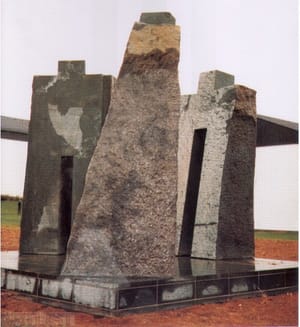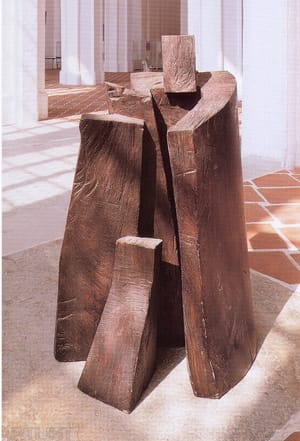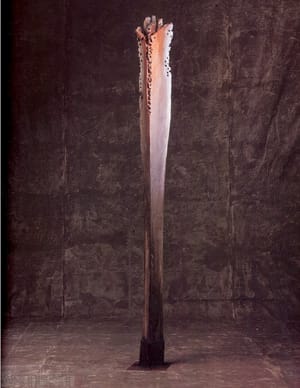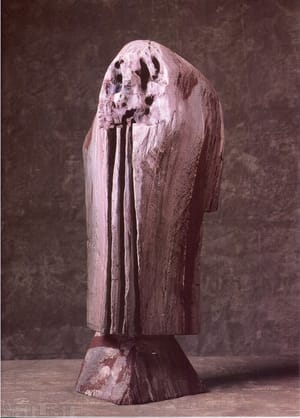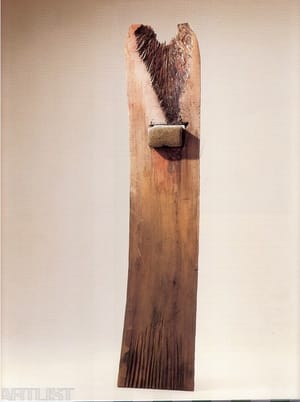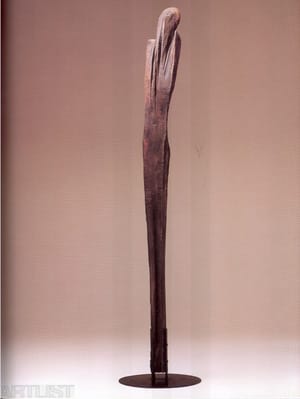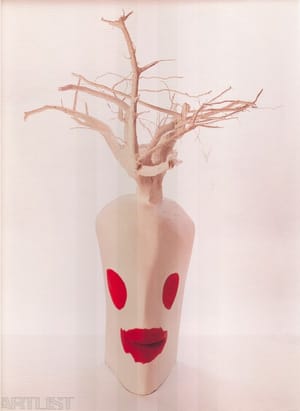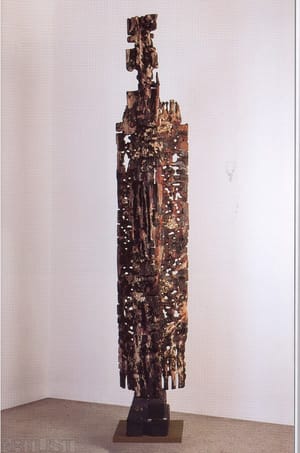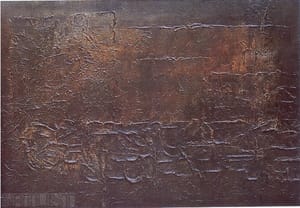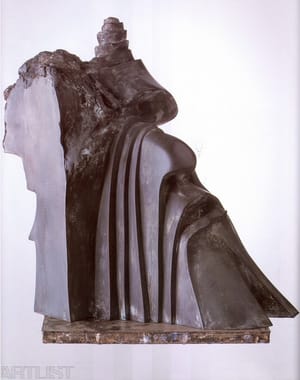- First Name
- Jan
- Surname
- Koblasa
- Born
- 1932
- Birth place
- Tábor
- Place of work
- Hamburg, Germany
- Died
- 2017
- CSU Library
- ↳ Find in the catalogue
About artist
Though his work includes paintings, graphics, drawing and stage design, Jan Koblasa regards himself above all as a sculptor. Since his studies in the 1950s, Koblasa has participated actively in public artistic life. The events he was involved in at that time had to be unofficial since they were in opposition to the predominant communist ideology. This includes his share in the organisation of the Malmuzherciáda (1954 Prague and the exhibition on Střelecký Island in Prague in 1957). This Dada performance became the core of the Šmidra Group (the group acquired its name in 1957). Other artists who became members included Bedřich Dlouhý, Karel Nepraš and Jaroslav Vožniak. The group’s performances were a student prank, a Dada gesture and a manifestation of resistance, not only to the official situation at that time, but to all conventions. From the start the happening-based soirées and meetings of the Šmidra Group were characterised by absurdity, weirdness, the grotesque, parodies, black humour and sarcasm rather than pure creativity. At that time Koblasa was drawn to abstract expressionism, as well as existentialist philosophy and musique concrète. In 1960, he played an important role in organising two famous unofficial exhibitions, Confrontations I. (in the Jiří Valenta studio) and Confrontations II. (in the Aleš Veselý studio). Both exhibitions became manifestations of non-figurative artworks.
The work of these artists was on the edge of picture and object. Participants in the Confrontations fundamentally rejected the compromises made by their predecessors, rejected the restraint of modernism of the inter-war generations, and turned instead to the tradition of West European art of the previous fifteen years, above all informel. Koblasa creates dark, abstract paintings with the texture typical of informel, evoking the embryonic traces of primeval sludge. Since the end of the 1950s he has continued to produce sculptures. At first sight these are abstract works made of plaster, wood or bronze, with a characteristic textural finish. However, their titles indicate that they are actually abstracted figures: the Martyrdom of St. Sebastian, Dead King, Magdalena, Weeping Youth, Head, Red Angel, False Prophet, etc. With their emphasis on archetypal and mythological elements the sculptures have a symbolic character. Koblasa finds an analogy with current life experience in their metaphorical message. He often returned to mythical themes in his later work also (Prophet, Messenger, Angel, Guardian, Golem).
In 1968 Jan Koblasa emigrated. The occupation of Czechoslovakia in August 1968 found him in Italy, whence he never returned. He obtained asylum in Northern Germany. In 1969 he established the department of free sculpture at the Muthesius Fachhochschule in Kiel, which he headed as professor until 1998. The works which he created after 1968 are difficult to place in any particular stylistic drawer. Shortly after emigrating Koblasa created an amorphously shaped cycle of heads (Lamento, Lick Tongue), in which he returned to clay modelling, which he then cast in bronze. Several heads are made of polychromatic artificial substances. These expressive heads can be perceived as a response to the torment he felt upon being obliged to leave his native land.
Later in emigration Koblasa moved towards a stripped down simplicity of plastic form. The sculptures of this time are marked by restraint and simplicity of form. The dramatic expressiveness of the existential angst expressed by the destruction of material disappears. In certain works the geometrisation of shape moves toward a highly reduced and free sculptural form. In his work in exile Koblasa continues to examine timeless subjects with a symbolic significance.
Thematically Koblasa’s work operates in several circles. One of these is the myth of Earth, visible in early informel works, e.g. in the cycle Finis Terrae. Later we find the theme appearing in the cycle made of diabase entitled Mountains. A simple form based on the contrast between the highly polished surface of natural looking parts loses its former expressiveness. It is an example of the artist’s more contemplative work extending into cosmological spheres.
From the end of the 1950s onwards Koblasa was interested in the theme of victim (The Martyrdom of St Sebastian, Obětina, Veronica’s Veil). However, he does not regard the symbol of the victim simply within a narrow historical context, but as a message with universal validity, as a metaphor for being thrown into (not always propitious) life. In 1989, he created a series of sculptures on this theme entitled Abraham and Isaac. The sculpture Dead Mother dates back to 1991 and 92, and Portrait of an Unknown Soldier I and II to 1993.
Another circle of Koblasa’s output comprises work exploring themes of cult idolatry. This would include early works such as the series of Kings or Magdalena. Sculptures of this type place a strong emphasis on verticality and full frontality, as in the ancient cultures of Greece and Egypt. The sculptures from later years, such as Niké (1984), Day and Night Watch (1989) and Seven Days (1989), also possess an archaic, majestic and grandiose atmosphere.
If we look at Koblosa’s work as a whole, it becomes clear that it is full of symbols and signs and that a return to myth and archetype plays a large role. The artist seeks solace in origins in response to today’s chaotic world. Jana Koblasa’s work can be characterised as a territory in which the message of ancient history (even prehistory) encounters the current state of life and the feelings of contemporary man.
- Author of the annotation
- Ivona Raimanová
CV
Studies:
1959 Academy of Performing Arts, Prague (F. Tröster)
1952-1958 Academy of Fine Art, Prague (O.Španiel, J. Lauda, K.Pokorný)
Awards:
1959 Junge Kunst Vídeň (Wien), Bronze
1958 Academy of Fine Arts Award Prague
- Member of art groups included in ARTLIST.
Exhibitions
- Solo exhibitions
-
2012
Jan Koblasa: Retrospektiva, Jízdárna Pražského hradu, Praha
2011
Jan Koblasa: Velký výstup / The Great Ascent, Brno Gallery CZ, Brno
2010
Zur Passion, Offene Kirche St. Nikolai zu Kiel, Kiel
Sochy, grafiky a kresby, Galerie La Femme, Praha
2008
Grafika 1959 - 2006, Galerie Art, Chrudim
2007
Skulpturen, Bilder, Zeichnungen, Graphik, Zum 75. Geburtstag, Galerie Christoph Dürr, Mnichov
2006
Hlubotisky 1956/2006, Galerie Hollar, Praha
Deník (Práce z let 1999 - 2000), Galerie Ztichlá klika, Praha
Dialogy s hmotou ..., Oblastní galerie Vysočiny v Jihlavě, Jihlava
Vizitka tvorby, Rožmberský dům, Soběslav
Dialogy s hmotou ..., Oblastní galerie v Liberci, Liberec
2004
Retrospektiva, Schloß Gottorf, Schleswig
Sochy a kresby, Galerie Bayer & Bayer, Řetězová, Praha
2002
Kresby 1960 - 1961, Galerie Ztichlá klika, Praha
Vítr, Galerie Caesar, Olomouc
Kde domov můj / Where is My Home. Emigrantovy sny 68 / Dreams of a ´68 Emigrant, Galerie Primavesi, Olomouc
2001
Archetypy, Hauptkirche Sankt Katharinen, Hamburk
Neue Arbeiten, Galerie Gardy Wiechern, Hamburk
2000
Galerie Noran, Panker
1999
Gallery 50ft, Chicago
Sochy, Egon Schiele Art Centrum, Český Krumlov
1998
Galerie Christel Fahrenhorst , Hameln
Skulpturen und Papierarbeiten, BKK Bundesverband, Essen
1997
Galerie Gardy Wiechern, Hamburk
Galerie Christel Fahrenhorst , Hameln
Apokalypsa, Galerie moderního umění v Roudnici nad Labem, Roudnice nad Labem
Monotypy a plastiky 1959-60, Galerie ´60/´70, Praha
Apokalypsa, Galerie Longa, Praha
Plastik, Bilder, Zeichnungen, Graphik, Galerie Christoph Dürr, Mnichov
Galerie Kruse, Flensburg
Plastik, Bilder, Zeichnungen, Graphik, Die Galerie, Berlín
1996
Marktkirche, Essen
Sochařská a malířská tvorba z 60. let, Galerie Longa, Praha
Neue Arbeiten, Schloss Agathenburg, Agathenburg
Skulpturen in Stein, Skulpturenpark Cuxhaven, Cuxhaven
1995
Galerie Aulos, Praha
Holzskulpturen 1962-1995, Förderverein Kulturzentrum Marstall e.V., Ahrensburg
1994
St. Petri zu Lübeck (Kirche), Lübeck
Skulpturen, Galerie Blau, Seeheim-Jugenheim1993 Arbeiten auf Papier, Museum Bochum, Bochum
1993
Skulpturen, Städtische Galerie, Hattingen
1992
Malby a plastiky z šedesátých let, Galerie plastik, Hořice
Memalte Skulpturen, Galerie Christoph Dürr, Mnichov
Skulpturen, Gartengalerie Klosterkielhof, Oldenburg
Malerei, grafik, Galerie 42, Oldenburg
Retrospektive zum 60. Geburstag, Sparkasse Kiel, Kiel
1991
Severočeská galerie výtvarného umění v Litoměřicích, Litoměřice
Galerie Gardy Wiechern, Hamburk
Galerie výtvarného umění v Chebu, Cheb
Galerie umění Karlovy Vary, Karlovy Vary
Sochy, Letohrádek královny Anny (Belveder), Praha
Muzeum, Teplice
Skulpturen, Kampnagelfabrik (Kampenagel Internationale Kulturfabrik), Hamburg
Galerie moderního umění v Hradci Králové, Hradec Králové
1990
Messe CAD CAM CNC, Mnichov
Galerie Metta Linde, Lübeck
1989
Landesmuseum Schloß Gottorf, Schleswig
Galerie Christoph Dürr, Mnichov
Ernst Deutsch Theater, Hamburk
Skulptur 1979 - 1989, Schloß Gottorf, Schleswig
1987
Galerie Sfeir-Semler, Kiel
1986
Steinskulpturen, Galerie Marianne Hennemann, Bonn
1987
Jan Koblasa, Galerie Christel Schüppenhauer, Essen
1985
Galerie Sfeir-Semler, Kiel
Galerie R+K Glas, Bad Tölz
Galleria Pagani, Legnano (Milano)
1984
Agonie, Kunstsammlungen Bochum, Bochum
Galerie Krause, Pfäffikon
Plastiken - Zeichnungen - Grafik, Galerie PRAgXIS C. Schüppenhauer, Essen-Kettwig
1984
Agonie, Galerie Christoph Dürr, Mnichov
1983
Plastiken 82 - 83, Galerie Nemo, Eckernförde
1982
Galerie Christoph Dürr, Mnichov
1981
Jan Koblasa: es war einmal ein Baum..., Galerie Marianne Hennemann, Bonn
Wiesen und Pfähle, Landesmuseum Schloß Gottorf, Schleswig
1980
Galerie Mauritz, Selent bei Kiel
Galerie Christoph Dürr, Mnichov
Plastiken, Zeichnungen, Bühnenbildentwürfe, Operhaus am Kleinen Kiel, foyer, Kiel
Zeichnungen, Plastiken, Galerie im Studio N, Kiel
1978
Bilder, Zeichnungen, Galerie Christoph Dürr, Mnichov
1976
Kunsthaus Lübeck, Lübeck
Steine, Galerie Lornsenstraße, Kiel
Plastik + Radierung, Galerie Mauritz, Selent bei Kiel
Kunsthalle zu Kiel, Kiel
Plastik, zeichnungen, Galerie Nieharde 12, Sterup
Jan Koblasa 1966 - 1976: Impressum, Museum Bochum, Bochum
1974
Apocalypsis, Galerie Christoph Dürr, Mnichov
Galerie Marianne Hennemann, Bonn1973 Galerie M, Kiel
1973
Sculptures & Etchings of Cycle Apocalypse, Zan Art Gallery, Victoria
Holzkirche, Friedrichsort
1972
Galerie Christoph Dürr, Mnichov
Plastik, graphik, Bürmeister Ludwig Reichert Haus, Ludwigshafen am Rhein
1971
Ca´Giustinian, Benátky
1970
Trondhjems Kunstforening, Trondheim
Stavanger Kunstforening, Stavanger
Oslo Kunstforening, Oslo
Graphiken und Plastiken, Stadtkloster, Kiel
Galleria Pagani, Milano
1969
Galleria Pagani, Milano
Museo d´Arte moderna, Legnano (Milano)
Masky a kostýmy k Lorenzacciovi, Divadlo Za branou, Praha
1968
Galerie Atelier Mensch, Hamburk
1966
Apokalypsa, Divadlo Za branou, Praha
Práce z let 1958 - 1965, Galerie Československý spisovatel, Praha
Skulpturen - bilder - zeichnungen, Städtische Kunstgalerie, Bochum
1965
Oblastní galerie v Liberci, Liberec
1964
Galerie výtvarného umění, Litoměřice
1961
Ateliér Jana Koblasy, Praha
1959
Ateliér Jana Koblasy, Praha
- Group exhibitions not included in ARTLIST.
-
2013
Výtvarné umění - výstava, Galerie Nová síň, Praha
2012
XX. letní keramická plastika / Summer Exhibition of Ceramic Sculpture, Hrad Klenová, Klenová
Pohyblivé iluze ´60, Galerie Moderna, Praha
2011
19. Letní keramická plastika / Summer Exhibition of Ceramic Sculpture, Hrad Klenová, Klenová
2010
Roky ve dnech: České umění 1945-1957, Městská knihovna, 2. patro, Praha
Sonia Jakuschewa, Jan Koblasa: Liebeszeichen, Galerie Maschmann, Lebrade
Liebeszeichen. Skulpturen von Jan Koblasa und Bildwerke von Sonia Jakuschewa, Kieler Kloster, Kiel
Liebeszeichen. Skulpturen von Jan Koblasa und Bildwerke von Sonia Jakuschewa, KirchenKail, Kiel
Realita je víc než fikce: Asambláž jako tvůrčí princip v českém umění 60. a 70. let, Dům pánů z Kunštátu, 1. patro, Brno
2009
České a slovenské výtvarné umenie šesťdesiatych rokov 20. storočia, Dům umění, Ostrava
Stopy ohně, Dům umění, Ostrava
2008
Sonia Jakuschewa, Jan Koblasa: ...und Moskau ist so weit..., Der Werkhof, Kiel
České a slovenské výtvarné umenie šesťdesiatych rokov 20. storočia, Galéria Miloša Alexandra Bazovského v Trenčíne, Trenčín
Na zkoušku v ráji? Umění šedesátých let ze sbírek Západočeské galerie v Plzni, Výstavní síň "13", Plzeň
České a slovenské výtvarné umenie šesťdesiatych rokov 20. storočia, Galéria Petra Michala Bohúňa, Liptovský Mikuláš
České a slovenské výtvarné umenie šesťdesiatych rokov 20. storočia, Krajská galerie výtvarného umění ve Zlíně, Zlín
2007
Hory, skály, kameny, Oblastní galerie Vysočiny v Jihlavě, Jihlava (Jihlava)
2006
Šmidrové: Jednou Šmidrou, Šmidrou na věky, Atrium na Žižkově, výstavní síň, Praha
Šedesátá / The sixties, Ze sbírky Galerie Zlatá husa v Praze, Galerie umění Karlovy Vary, Karlovy Vary
České poválečné umění, Galerie U Betlémské kaple, Praha 2006/04/26 - 2006/05/28 Česká grafika 60. let, Galerie Hollar, Praha
Emigration out/in 2: Hugo Demartini, Jan Koblasa, Jan Kotík, Theodor Pištěk, Aleš Veselý, Saarländischen Galerie, Berlín
Bedřich Dlouhý, Jan Koblasa, Jan Kotík, Theodor Pištěk: Emigrace out/in 2, Saarländischen Galerie, Berlín
České umění 20. století, Alšova jihočeská galerie v Hluboké nad Vltavou, Hluboká nad Vltavou
V závěsu avantgardy? České výtvarné umění 1956 - 1978 ze sbírek Muzea umění Olomouc, Muzeum umění Olomouc - Muzeum moderního umění, Olomouc
Hory, skály, kameny, Výstavní síň Husova 19-21, Praha
2005
La boîte en valise - oder Die Neue Welt liegt mitten in Europa, Akademie der bildenden Künste, Norimberk
Šmidrové: Jednou Šmidrou, Šmidrou na věky, Hrad Bítov, Bítov (Znojmo) 2005/07/18 - 2005 Místa paměti, Galerie Šternberk, Šternberk
Šmidrové, Galerie Šternberk, Šternberk
2004
Ohlédnutí, 2. část, Oblastní galerie v Liberci, Liberec
La boîte en valise - oder Die Neue Welt liegt mitten in Europa, Kunstverein, Weiden
Šedesátá / The sixties, Ze sbírky Galerie Zlatá husa v Praze, Dům umění města Brna, Brno
Blízká vzdálenost/ Közeli távolság/ Proximate Distance, Szent István Király Múzeum, Székesfehérvár
2003
Umění je abstrakce: Česká vizuální kultura 60. let, Jízdárna Pražského hradu, Praha
Umění je abstrakce: Česká vizuální kultura 60. let, Uměleckoprůmyslové muzeum, Brno
Prameny / Quellen - Kunst aus der Mitte Europas, Stolpe, Stolpe
2001
Barevná socha, Severočeská galerie výtvarného umění v Litoměřicích, Litoměřice
2000
Současná minulost: Česká postmoderní moderna 1960-2000, Alšova jihočeská galerie, Hluboká nad Vltavou
Konec světa? / The End of the World?, Palác Kinských, Praha
Alfa 2000 omega, Galerie moderního umění v Roudnici nad Labem, Roudnice nad Labem
Alfa 2000 omega, Oblastní galerie Vysočiny v Jihlavě, Jihlava
100 + 1 uměleckých děl z dvacátého století / 100 + 1 Art Works of the Twentieth Century, Dům U černé Matky Boží, Praha
1999
Propheten im Garten, Nordelbischen Bibelzentrum St. Johanniskloster Schleswig, Schleswig
Mikuláš Medek: Obrazy, Jan Koblasa: Plastiky, Hrad Bítov, Bítov (Znojmo)
Umění zrychleného času. Česká výtvarná scéna 1958 - 1968, Praha,
1998
Tendence 60. let. Informel, nová figurace, konstruktivní umění, Trigon Gallery, Plzeň
Český informel ve Ztichlé klice / Czech informel in Ztichla klika (1958 - 1965),
Galerie Ztichlá klika, Praha
1997
České imaginativní umění, Galerie Rudolfinum, Praha
German expressive Art. Works on Paper, Gregory Gallery, New York, New York
1996
I. nový zlínský salon, Zlín
V prostoru 20. století, České umění ze sbírky Galerie hlavního města Prahy, Městská knihovna, výstavní sály, Praha
Osudová zalíbení. Sběratelé moderního umění i. 1900 - 1996, Veletržní palác, Praha
Novozákonní motivy v Českém umění 20. století, Galerie moderního umění v Roudnici nad Labem, Roudnice nad Labem
Klassenarbeit echt wahr, Landeskulturzentrum Salzau, Salzau
Zámek Klenová, Klenová 1997/01 - 1997/02 Novozákonní motivy v Českém umění 20. století, Galerie umění Karlovy Vary, Karlovy Vary
1995
Jan Koblasa: Skulpturen, Sonja Jakuschewa, Galerie Groll, Naarden - Vesting
Starozákonní motivy v českém umění dvacátého století, Galerie moderního umění v Roudnici nad Labem, Roudnice nad Labem
Starozákonní motivy v českém umění dvacátého století, Galerie umění Karlovy Vary, Karlovy Vary
1994
Česká grafika šedesátých let, Palác Kinských, Praha
Šedá cihla 66/1994 Exil, Galerie U Bílého jednorožce, Klatovy
Šedá cihla 66/1994 Exil, Zámek Klenová, Klenová
Ohniska znovuzrození, Městská knihovna, Praha
Zwischen Chaos und Ordnung, Städtische Galerie, Dreieich
1$993
Záznam nejrozmanitějších faktorů… České malířství 2. poloviny 20. století ze sbírek státních galerií, Jízdárna Pražského hradu, Praha
1992
Bronz, Vojanovy sady, Praha
České výtvarné umění 1900 1960, Středočeská galerie, Praha
1991
Český informel: Průkopníci abstrakce z let 1957 - 1964, Praha
Mikuláš Medek: Obrazy, Jan Koblasa: Plastiky, Severočeská galerie výtvarného umění v Litoměřicích, Litoměřice
Mikuláš Medek: Obrazy, Jan Koblasa: Plastiky, Státní galerie výtvarného umění v Chebu, Cheb
České malířství a sochařství 2. poloviny 20. století ze sbírek AJG, Alšova jihočeská galerie v Hluboké nad Vltavou, Hluboká nad Vltavou
Mikuláš Medek: Obrazy, Jan Koblasa: Plastiky, Galerie umění Karlovy Vary, Karlovy Vary
Europäische Dialoge 1991 / 1. festival Des Europäischen Kulturklubs, Museum Bochum, Bochum
Mikuláš Medek: Obrazy, Jan Koblasa: Plastiky, Krajské muzeum, Teplice
Mikuláš Medek: Obrazy, Jan Koblasa: Plastiky, Krajská galerie, Hradec Králové
1989
Engel - Bilder, Skulpturen, Objekte, Gnadenkirche, Hamburg
Wo bleibst Du, Revolution?, Museum Bochum, Bochum
1988
Hans-Martin Ihme, Jan Koblasa, Galerie Kreuzburg, Brémy
Přírůstky 1985 - 1987, Staroměstská radnice, 2. patro, Praha
1987
Das andere Land, Lothringer Straße / halle, Mnichov
Das andere Land, Herrenhäuser Gärten, Hannover
Das andere Land, Wilhelm-Hack-Museum, Ludwigshafen am Rhein
1986
Jan Koblasa, Johannes Michler, D. Kosswig, Galerie Metta Linde, Lübeck
Das andere Land, Schloß Charlottenburg, Berlín
Das andere Land, Museum Bochum, Bochum
Das andere Land, Paulskirche, Frankfurt nad Mohanem
Das andere Land, Stadtgalerie Saarbrücken, Saarbrücken
Das andere Land, Galerie Kultur unterm Turm, Stuttgart
1984
Jan Koblasa, J. Schmidt, Scharnhorsthalle, Münster
1983
Das Prinzip Hoffnung. Aspekte der Utopie in der Kunst und Kultur des 20. Jahrhunderts, Museum Bochum, Bochum1981 Skulptur im öffentlichen Raum - 3. Ausstellung figurlicher Plastik - Klein Skulpturen, Galerie Gruppe Grün, Brémy
1981
Skulptur im öffentlichen Raum - 3. Ausstellung figurlicher Plastik, Wallanlagen, Brémy
1980
Die Kunst Osteuropas im 20. Jahrhundert, Garmisch-Partenkirchen, Garmisch-Partenkirchen
1976
Jan Koblasa, Mikulas Medek, Museum Bochum, Bochum
1974
Bildhauerische Arbeitsprozesse, Ausstellungspavillon, Kiel
Tschechische Künstler, Galerie Wendtorf + Swetec, Düsseldorf1972 Tschechische Künstler, Galerie Studio Orny, Mnichov
1972
35 artisti cecoslovacchi contemporanei Grafica e oggetti, Unimedia Galeria d´arte contemporanea, Genova1970 Mikuláš Medek: Obrazy, Jan Koblasa: Plastiky, Galleria Pagani, Milano
1970
Tschechische Skulptur des 20. Jahrhunderts, von Myslbek bis zur Gegenwart, Schloß Charlottenburg, Berlín
1969
Jan Koblasa, Jiří Valenta, Kunstverein Hannover, Hannover
Jan Koblasa, Jiří Valenta, Schloß Celle, Celle
Mikuláš Medek: Obrazy, Jan Koblasa: Plastiky, Galleria Civica D'Arte Moderna, Cittá di Legnano, Legnano (Milano)
Sept jeunes peintres tchécoslovaques, Galerie Lambert, Paříž
Mikuláš Medek: Obrazy, Jan Koblasa: Plastiky, Galleria Pagani, Milano
Phases, Oblastní galerie Vysočiny v Jihlavě, Jihlava
1968
Alternative attuali III. Rassegna internazionale d´arte contemporanea. Aspetti della nuova scultura in Europa, Castello Spagnolo, L´Aquila
Socha piešťanských parkov '68, Kúpelový ostrov, Piešťany1967 Moderne Kunst aus Prag, Caroline-Mathilde-Räume im Celler Schloß, Celle
1967
Moderne Kunst aus Prag, Wilhelm-Morgner-Haus, Soest
Moderne Kunst aus Prag, Schleswig-Holsteinischer Kunstverein, Kiel
Fantasijní aspekty současného českého umění, Oblastní galerie Vysočiny v Jihlavě, Jihlava
Fantasijní aspekty současného českého umění, Galerie Václava Špály, Praha
1966
Nové cesty: Přehlídka současné avantgardy, Dům umění, Zlín
Jarní výstava, Mánes, Praha
Aktuální tendence českého umění. Obrazy, sochy, grafika, Praha, Praha
Výstava mladých, Dům pánů z Kunštátu, Brno
1965
Jan Koblasa, Jiří Kolář, Jan Kotík, Haus am Lützowplatz, Berlín
Sochařská bilance 1955 - 1965, Olomouc
La transfiguration de l´art tcfhéque: Peinture - sculpture - verre - collages, Palais de Congres, Liege
1964
Výstava D, Galerie Nová síň, Praha
Obrazy a plastiky, Oblastní galerie výtvarného uměni, Litoměřice
Socha 1964, Liberec, Liberec
1963
Hluboká 1963. Umění 1900-1963, Alšova jihočeská galerie v Hluboké nad Vltavou
Jan Koblasa, Mikuláš Medek: Výstava obrazů z let 1959 - 1963, Vlastivědné muzeum, Teplice
Rychnov 1963, Zámek Rychnov nad Kněžnou, Rychnov nad Kněžnou
1962
Argumenty 1962, Galeria Sztuki Nowoczesnej, Varšava
1960
Konfrontace I, Ateliér Jiřího Valenty, Praha
Konfrontace II, Ateliér Aleše Veselého, Praha
1957
Výstava na jeden den, Střelecký ostrov, Praha
1954
Malmuzherciáda, Klub unitářů, Praha
- Collections
-
Alšova jihočeská galerie v Hluboké nad Vltavou, Hluboká nad Vltavou
České muzeum výtvarných umění, Praha
Galerie hlavního města Prahy, Praha
Galerie moderního umění v Hradci Králové, Hradec Králové (Hradec Králové)
Galerie výtvarného umění, Ostrava
Galerie výtvarného umění v Chebu, Cheb
Hamburger Kunsthalle, Hamburg
Kiel - Kunsthalle, Kiel
Krajská galerie výtvarného umění ve Zlíně, Zlín
Krajské muzeum, Teplice
Kunsthalle, Norimberk
Landesmuseum Schleswig, Schleswig
Miami MOMA,
Museo d´Arte Moderna, Legnano (Milano)
Museum Bochum, Bochum
Museum Throlheim,
Muzeum umění Olomouc, Olomouc
Národní galerie v Praze, Praha
Oblastní galerie v Liberci, Liberec
Památník Terezín, Terezín
Philadelphia Museum of Art, Philadelphia
Severočeská galerie výtvarného umění v Litoměřicích, Litoměřice
Stedelijk Museum, Amsterodam
Západočeská galerie v Plzni, Plzeň
- Other realisations
Symposiums:
2003
Mezinárodní sochařské sympozium, Klášter Hradiště nad Jizerou (Mladá Boleslav)
2001
Mezinárodní sochařské sympozium, Klášter Hradiště nad Jizerou (Mladá Boleslav)
1999
Mezinárodní sochařské sympozium, Klášter Hradiště nad Jizerou (Mladá Boleslav)
1990
Mezinárodní sochařské symposium, Hořice v Podkrkonoší
1989
1. Internationales Bildhauersymposion Neumünster, Německo
International Symposium for Peace, Eilat (Izrael)
1988
Workshop, Sharon (USA)
1983
Steinbilhauersymposium, Lübeck
1982
Steinsymposium, Schloss Gottorf, Schleswig
1974
Internationales Kunsstoffsymposium, Lindau, Bodensee
1967
Mezinárodní sochařské sympozium (ve dřevě), Pieš´tany
1966
Mezinárodní sympozium o urbanistice a volném čase, Liberec
Monography
- Monography
Jan Koblasa. Texty: Josef Hlaváček a Mahulena Nešlehová. Nakladatelství Karolinum, Praha 2002.
